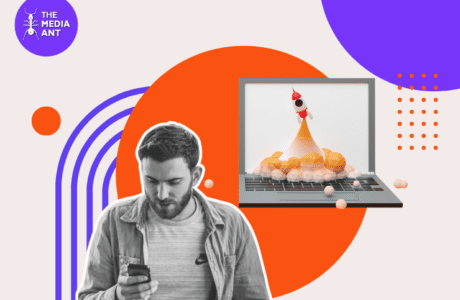Imagine walking into your favorite coffee shop. The rich aroma of freshly brewed coffee fills the air, a soothing acoustic playlist hums in the background, the warm glow of ambient lighting sets the mood, and as you take your first sip, the familiar taste instantly lifts your spirits. You don’t just buy coffee—you experience it. That’s the magic of sensory marketing!
In a world where consumers are bombarded with endless ads and promotions, brands that engage multiple senses stand out and create lasting impressions. From the satisfying click of an Apple MacBook lid to the nostalgic jingle of a childhood candy brand, sensory elements tap into emotions, enhance recall, and build deep connections. But how does this strategy work, and how can businesses harness it effectively? Let’s dive in.
What is Sensory Marketing?
Sensory marketing is a strategy that appeals to the five human senses—sight, sound, touch, taste, and smell—to influence consumer behavior. Unlike traditional marketing, which heavily relies on visuals, sensory marketing engages multiple senses to create a more immersive brand experience. This technique helps brands connect with consumers on an emotional level, making interactions more memorable and persuasive. For example, when you walk into a high-end store and are greeted with a specific scent, calming background music, and plush carpeting, you subconsciously associate these sensory triggers with luxury and exclusivity. By activating these sensory cues, brands can craft powerful narratives that influence purchasing decisions and build long-term customer loyalty.
The Science Behind Sensory Marketing
Sensory marketing is deeply rooted in neuroscience and psychology. Research shows that the brain processes sensory stimuli faster and more effectively than purely rational information.
- Smell and Emotion: The olfactory bulb, responsible for processing scents, is directly linked to the brain’s limbic system, which controls emotions and memory. This is why a particular perfume or the smell of baked cookies can instantly transport you back to a childhood memory.
- Touch and Perception: Studies reveal that people perceive heavier objects as more valuable. This explains why premium smartphones or luxury pens are designed with a certain weight to enhance their perceived worth.
- Sound and Recognition: Audio branding (e.g., jingles, signature sounds) helps consumers instantly recognize brands. A classic example is Intel’s signature startup sound, which triggers immediate brand recognition.
Understanding these psychological principles allows brands to craft multisensory experiences that strengthen consumer connections and improve brand recall.
The Five Senses in Marketing
Visual Marketing: More Than Just Aesthetics
Visual appeal is the most dominant aspect of marketing, influencing first impressions and brand perception. Effective visual marketing extends beyond colors and logos—it encompasses design, layout, typography, and packaging.
Example:
- Bose uses a minimalist yet sophisticated design to communicate luxury and quality. The sleek black and silver packaging of their headphones gives off a high-end, premium feel.
- Tata Motors leverages visually appealing advertisements to position its vehicles as powerful and stylish, with high-definition video content and innovative digital ads.
Auditory Marketing: The Sound of Brand Recognition
Sounds create strong brand associations and trigger emotions. From background music in retail stores to sonic logos, auditory elements enhance brand recall and influence purchasing behavior.
Example:
- Airtel’s iconic jingle, “Airtel, Har Ajaib Hai,” instantly resonates with Indian audiences and reinforces the brand’s presence.
- Café Coffee Day has its catchy jingles and music that play in stores, creating a specific mood and customer expectation. The sound of the coffee machine brewing espresso also triggers a sensory connection with the brand.
Olfactory Marketing: The Power of Scents
Scent is one of the most powerful memory triggers. A signature scent can make a brand instantly recognizable and create a strong emotional bond with consumers.
Example:
- The Body Shop uses signature fragrances like “Mango” and “Rose” in-store to evoke relaxation and pleasure.
- Westside retail stores often diffuse soft floral or woody fragrances to create a sense of calm and luxury.
- Titan Watches‘ luxury stores have signature smells to reflect the sophistication and exclusivity of their brand.
Tactile Marketing: The Feel of Quality
The sense of touch influences how people perceive a product’s quality. The texture of packaging, product weight, and material choice all contribute to brand perception.
Example:
- Raymond uses premium fabric materials in its packaging and store displays to communicate luxury. When you touch a Raymond suit or fabric, it feels smooth and superior, reinforcing the brand’s high-quality promise.
- Bata India also capitalizes on tactile experiences with its footwear, focusing on comfort and durability, which customers can feel the moment they try on the shoes.
Gustatory Marketing: The Taste of Branding
Taste plays a crucial role in the food and beverage industry. A distinct taste experience can create brand loyalty and customer preference.
Example:
- Amul‘s iconic dairy products, such as its butter and ice cream, have a distinct taste that customers instantly recognize.
- Coca-Cola India has successfully used its unique formula to make it synonymous with refreshment, with every sip bringing back memories of fun moments and family gatherings.
- Haldiram’s has also built a strong brand identity through its signature snacks and sweets, which customers return to for their authentic Indian flavors.
What are the Advantages and Disadvantages of Sensory Marketing?
Sensory marketing has the power to transform how consumers perceive and engage with brands, but like any strategy, it comes with its strengths and challenges. Understanding these can help businesses make informed decisions about implementing sensory-driven campaigns.
Advantages of Sensory Marketing:
- Enhances Brand Recall: Engaging multiple senses strengthens memory retention, making it easier for customers to remember and recognize a brand. A unique sound, scent, or texture can create a lasting imprint in a consumer’s mind.
- Creates Emotional Connections: Sensory elements tap into emotions, which play a significant role in decision-making. Brands that evoke nostalgia, excitement, or comfort through sensory experiences develop deeper customer relationships.
- Boosts Customer Engagement: A multi-sensory brand experience captivates consumers more effectively than traditional advertising. Whether it’s the rich aroma of a store or the tactile feel of a premium package, sensory interactions enhance the overall shopping experience.
- Differentiates the Brand: In a crowded marketplace, sensory branding helps a company stand out. A signature fragrance, a distinctive jingle, or even a well-crafted unboxing experience can make a brand more memorable than its competitors.
- Encourages Word-of-Mouth Marketing: Unique sensory experiences often lead to organic conversations. When consumers find a scent, sound, or touch experience particularly enjoyable, they are more likely to share their experience with others, amplifying brand awareness.
Disadvantages of Sensory Marketing:
- High Implementation Costs: Crafting a multi-sensory experience often requires significant investment in research, product development, and branding. Customizing elements like scents or tactile packaging can be expensive.
- Difficult to Measure ROI: Unlike digital marketing strategies that rely on measurable KPIs, sensory marketing’s impact on consumer behavior is harder to track and quantify.
- Cultural and Regional Sensitivities: Sensory preferences vary across demographics and regions. A scent that evokes comfort in one country may be unappealing in another. Businesses must carefully tailor sensory strategies to their target audience.
- Risk of Overstimulation: Overloading consumers with too many sensory elements can have an adverse effect, making an experience overwhelming or even unpleasant. Striking the right balance is crucial.
Despite these challenges, when executed well, sensory marketing has the potential to create compelling and unforgettable brand experiences that drive consumer engagement and loyalty.?
Advantages:
- Enhances Brand Recall – Multi-sensory experiences create stronger and longer-lasting brand associations.
- Increases Emotional Connection – Engaging multiple senses strengthens emotional bonds with consumers.
- Boosts Customer Engagement – Sensory experiences make interactions more immersive and memorable.
- Differentiates Brands – Sensory elements help brands stand out in crowded markets.
Disadvantages:
- Costly Implementation – Designing multi-sensory experiences can be expensive.
- Difficult to Measure ROI – Tracking the direct impact of sensory marketing can be challenging.
- Cultural Differences – Sensory preferences vary across regions, making global implementation tricky.
Sensory Marketing in Digital and E-commerce
Even in the digital world, where physical touch and scent are absent, brands have found innovative ways to appeal to consumers’ senses. Sensory marketing in e-commerce and digital spaces focuses on immersive visual and auditory experiences, along with indirect tactile elements to enhance engagement and brand recall.
- Visual Marketing in Digital Spaces: High-resolution product images, interactive website designs, and dynamic video content help brands create a visually appealing experience. For example, luxury brands use 360-degree product views and AR-powered try-on features to mimic an in-store shopping experience.
- Auditory Branding in E-Commerce: Brands use sound to reinforce identity and enhance user experience. E-commerce platforms often integrate sound effects—such as confirmation chimes or app notifications—to create positive reinforcement. Brands like Mastercard have even developed their own sonic identities, playing signature tunes with every transaction.
- Tactile Sensory Marketing in Tech: While digital platforms lack direct touch, brands are exploring ways to engage this sense. Features like haptic feedback in smartphones (such as Apple’s Taptic Engine) simulate a sense of touch, making digital interactions feel more lifelike.
- Olfactory & Gustatory Innovations: Though challenging in digital environments, technology is evolving to simulate these senses. Some companies are experimenting with scent-releasing devices connected to digital advertisements, while AR and VR experiences are being developed to mimic taste and smell interactions in virtual stores.
Brands that integrate sensory marketing into their digital and e-commerce strategies create more engaging, immersive, and memorable online experiences. By leveraging AI, AR, and other emerging technologies, businesses can bridge the gap between the physical and digital worlds, ensuring consumers feel connected to their products even when shopping remotely. Even in digital spaces, brands leverage sensory marketing techniques to create engaging experiences:
How Does Sensory Marketing Increase Brand Recall and Loyalty?
Engaging multiple senses strengthens neural pathways associated with a brand, leading to better recall and higher customer retention. A fragrance used in a retail store, combined with a unique visual identity and soothing background music, creates a holistic brand experience that customers remember and return to.
Step-by-Step Guide to Building a Sensory Marketing Strategy
Building an effective sensory marketing strategy requires a structured approach that aligns with your brand’s identity and audience expectations. Here’s how to craft an unforgettable multi-sensory experience:
- Identify Core Brand Attributes – Define the emotions and experiences you want to evoke. Ask: What feelings should customers associate with your brand? For example, a luxury brand may want to evoke sophistication, while a fitness brand might aim for energy and motivation.
- Choose Sensory Triggers – Select key senses that align with your brand message. Consider the following:
- Sight: Logo, color palette, and store design.
- Sound: Signature tunes, jingles, or product sounds (e.g., the Mac startup chime).
- Touch: Packaging texture, product weight, and materials.
- Smell: Custom scents in stores or product fragrances.
- Taste: Unique flavors for food and beverage brands.
- Sight: Logo, color palette, and store design.
- Experiment and Optimize – A/B test different sensory elements to see what resonates. For instance, test multiple background music tracks in a store to determine which leads to higher engagement. In digital spaces, brands can experiment with colors and sound effects to enhance customer experience.
- Ensure Consistency – Maintain a uniform sensory identity across all touchpoints. The same sensory elements should be integrated across physical stores, advertisements, websites, and even packaging to create a seamless brand experience.
- Adapt to Trends – Stay updated with technological advancements like VR, AR, and AI-driven personalization. As immersive technologies evolve, brands should explore new ways to incorporate sensory marketing into their customer engagement strategies.
By following this structured approach, businesses can build a compelling sensory marketing strategy that captivates customers and strengthens brand loyalty.
Future of Sensory Marketing
The future of sensory marketing is set to be more immersive, data-driven, and technologically advanced than ever before. As consumer expectations evolve, brands will leverage cutting-edge innovations to create hyper-personalized, multi-sensory experiences that seamlessly blend the physical and digital worlds.
- AI & Personalization: Artificial intelligence will play a crucial role in tailoring sensory experiences to individual preferences. Brands will use AI-driven data analytics to determine which sensory triggers resonate most with specific customers, delivering customized marketing campaigns that adapt in real-time.
- Augmented & Virtual Reality: AR and VR will allow consumers to interact with products in lifelike environments before making a purchase. Imagine being able to “smell” a new perfume through digital scent technology or “feel” the texture of a luxury handbag through haptic feedback in a virtual store. These innovations will make online shopping as sensory-rich as an in-store experience.
- Neuro-Marketing: Advances in neuroscience will enable brands to understand how different sensory stimuli impact consumer decision-making on a deeper level. Brainwave analysis and biometric tracking will provide insights into emotional responses, allowing marketers to craft campaigns that trigger the strongest psychological reactions.
- Multisensory Smart Packaging: The rise of smart packaging will revolutionize product experiences. Packages embedded with interactive features—such as QR codes that play a signature brand sound or temperature-sensitive materials that change texture—will elevate the unboxing experience and deepen brand engagement.
- Sensory-Enhanced Digital Content: As content consumption moves toward more immersive formats, brands will integrate multi-sensory elements into their digital storytelling. From ASMR-inspired product videos to scent-enabled advertisements, sensory marketing will redefine how consumers engage with content online.
The brands that stay ahead will be those that embrace these innovations, ensuring that their sensory marketing strategies are not only memorable but also deeply connected to the evolving desires of modern consumers. The future promises a world where brand experiences are not just seen or heard—but truly felt. The evolution of technology is shaping the future of sensory marketing:
Conclusion
Sensory marketing is a powerful tool that enables brands to create immersive experiences that captivate consumers and foster long-term loyalty. By engaging multiple senses, brands can form deeper emotional connections, enhance brand recall, and stand out in competitive markets. As technology advances, the opportunities for innovative sensory experiences will continue to grow, making it an essential strategy for future brand success.
FAQs about sensory marketing:
What is an example of sensory marketing?
An example of sensory marketing is Starbucks’ use of aroma. The rich scent of freshly brewed coffee that fills the store engages the olfactory sense, enhancing the overall customer experience and making the store feel welcoming. Similarly, Apple’s minimalist store design, with its sleek visuals and tactile experience of the products, engages multiple senses to promote its premium brand image.
How do brands use sensory marketing?
Brands use sensory marketing by incorporating sensory elements—sight, sound, touch, taste, and smell—into their branding and customer experience strategies. For example, brands may create visually appealing advertisements, use signature sounds (like Intel’s startup chime), design unique packaging textures, or even incorporate specific scents in stores to evoke certain emotions. These sensory cues create an emotional connection, making customers more likely to remember and engage with the brand.
How does Starbucks use sensory marketing?
Starbucks uses sensory marketing in several ways. The aroma of fresh coffee beans brewing in their stores appeals to the olfactory sense, making customers feel relaxed and welcomed. They also have a specific ambience created through soft lighting and calming music, contributing to an overall experience that customers associate with comfort and quality. The tactile feel of the cups, along with their signature green and white branding, reinforces the premium, inviting nature of the brand.
How does Coca-Cola use sensory marketing?
Coca-Cola employs sensory marketing through the distinct sound of a soda bottle opening, its vibrant red and white colours, and the unique taste that is immediately recognizable to consumers. Their advertisements often emphasize sensory experiences, with the refreshing sound of a Coke being opened or poured and the visual imagery of people enjoying the drink in various settings, creating strong emotional associations. The brand also uses its signature bottle shape and iconic contour design to trigger positive sensory memories in customers.





